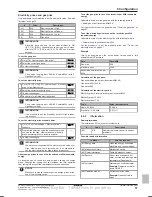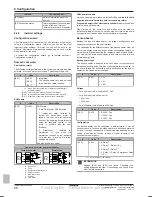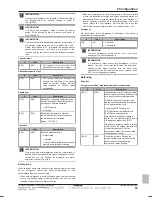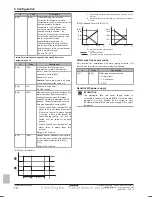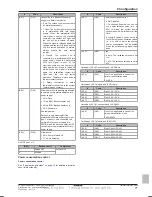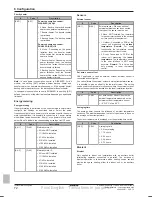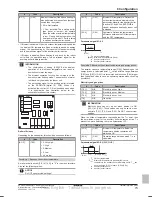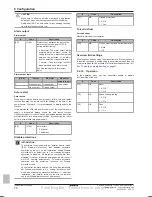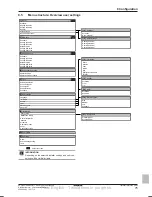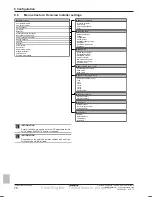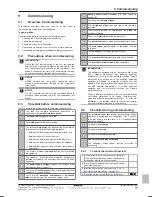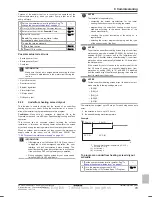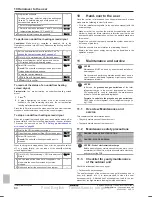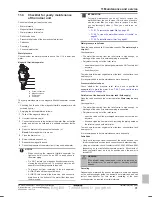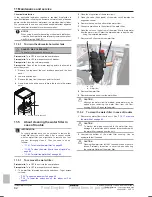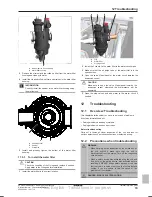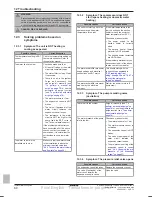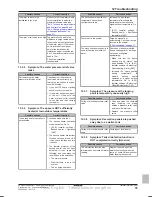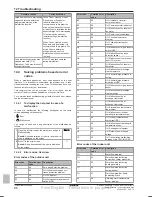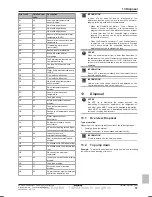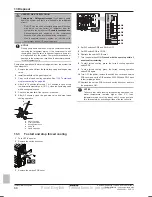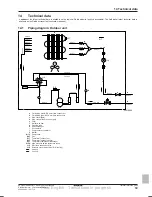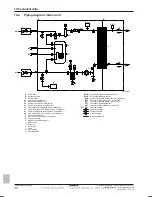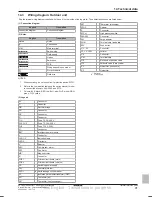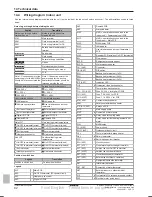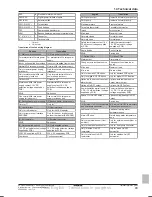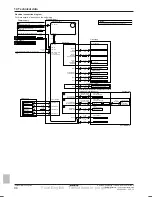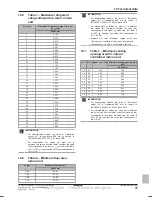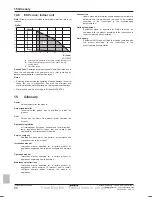
11 Maintenance and service
Installer reference guide
81
ERGA04~08DAV3(A) + EHVH/X04+08S18+23DA
Daikin Altherma – Low temperature split
4P495248-1 – 2017.12
11.4
Checklist for yearly maintenance
of the indoor unit
Check the following at least once a year:
▪ Water pressure
▪ Magnetic filter/dirt separator
▪ Water pressure relief valve
▪ Relief valve hose
▪ Pressure relief valve of the domestic hot water tank
▪ Switch box
▪ Descaling
▪ Chemical disinfection
Water pressure
Check whether the water pressure is above 1 bar. If it is lower, add
water.
Magnetic filter/dirt separator
b
a
c
d
a
Screw connection
b
Magnetic sleeve
c
Drain valve
d
Drain cap
The yearly maintenance of the magnetic filter/dirt separator consists
of:
▪ Checking if both parts of the magnetic filter/dirt separator are still
screwed tight (a).
▪ Emptying the dirt separator as follows:
1
Take off the magnetic sleeve (b).
2
Unscrew the drain cap (d).
3
Connect a drain hose to the bottom of the water filter so that the
water and dirt can be collected in a suitable container (bottle,
sink...).
4
Open the drain valve for a couple of seconds (c).
Result:
Water and dirt will come out.
5
Close the drain valve.
6
Screw the drain cap back on.
7
Reattach the magnetic sleeve.
8
Check the pressure of the water circuit. If required, add water.
NOTICE
▪ When checking the magnetic filter/dirt separator for
tightness, hold it firmly, so as NOT to apply stress to
the water piping.
▪ Do NOT isolate the magnetic filter/dirt separator by
closing the shut‑off valves. To properly empty the dirt
separator, sufficient pressure is required.
▪ To prevent dirt from remaining in the dirt separator,
ALWAYS take off the magnetic sleeve.
▪ ALWAYS first unscrew the drain cap, and connect a
drain hose to the bottom of the water filter, then open
the drain valve.
INFORMATION
For yearly maintenance, you do not have to remove the
water filter from the unit to clean it. But in case of trouble
with the water filter, you might have to remove it so that
you can thoroughly clean it. Then you need to do as
follows:
▪
"11.5.1 To remove the water filter" on page 82
▪
"11.5.2 To clean the water filter in case of trouble" on
page 82
▪
"11.5.3 To install the water filter" on page 83
Water pressure relief valve
Open the valve and check if it operates correctly.
The water may be
very hot!
Checkpoints are:
▪ The water flow coming from the relief valve is high enough, no
blockage of the valve or in between piping is suspected.
▪ Dirty water coming out of the relief valve:
▪ open the valve until the discharged water does NOT contain dirt
anymore
▪ flush the system
To make sure this water originates from the tank, check after a tank
heat up cycle.
It is recommended to do this maintenance more frequently.
Pressure relief valve hose
Check whether the pressure relief valve hose is positioned
appropriately to drain the water. See
"7.8.5 To connect the drain
hose to the drain" on page 40
.
Relief valve of the domestic hot water tank (field supply)
Open the valve and check the correct operation.
Water may be very
hot!
Checkpoints are:
▪ The water flow coming from the relief valve is high enough, no
blockage of the valve or in between piping is suspected.
▪ Dirty water coming out of the relief valve:
▪ open the valve until the discharged water does not contain dirt
anymore
▪ flush and clean the complete tank, including the piping between
the relief valve and cold water inlet.
To make sure this water originates from the tank, check after a tank
heat up cycle.
It is recommended to do this maintenance more frequently.
Switch box
▪ Carry out a thorough visual inspection of the switch box and look
for obvious defects such as loose connections or defective wiring.
▪ Using an ohmmeter, check if contactors K1M, K2M, K3M and K5M
(depending on your installation) operate correctly. All contacts of
these contactors must be in open position when the power is
turned OFF.
WARNING
If the internal wiring is damaged, it has to be replaced by
the manufacturer, its service agent or similarly qualified
persons.
Descaling
Depending on water quality and set temperature, scale can deposit
on the heat exchanger inside the domestic hot water tank and can
restrict heat transfer. For this reason, descaling of the heat
exchanger may be required at certain intervals.
Final English - Tanslations in progress

